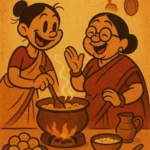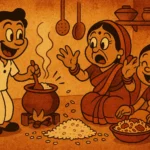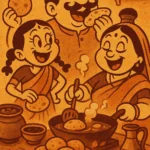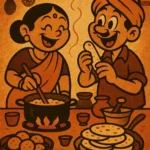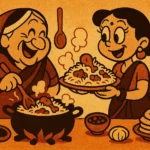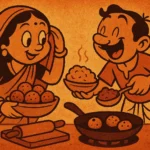I’ve spent years cooking with a set of ingredients that are often more about instinct than measurements. I didn’t learn how much salt to add to dal by measuring a teaspoon and a half—it was always about a pinch here and a dash there, the kind of cooking that you can only describe with the word “eyeballing.” Growing up in Mumbai, I watched my mom cook. I was never given a recipe card or a list of instructions. She didn’t measure anything. “A little bit of this, a little bit of that,” she’d say, and it worked. It always worked. But somehow, no matter how many times I tried to replicate it, it never tasted quite the same. And that, I’ve realized, is the essence of Indian cooking: it’s less about precision and more about intuition, emotion, and memory.
When I moved to Austin, Texas, and began cooking for myself, I found myself missing that sense of freedom. In the U.S., everything was about exact measurements. Recipes came with lists: “1 cup of this,” “2 tablespoons of that.” It felt like I was being asked to follow a science experiment rather than cooking a meal with love. But Indian food, the way I learned it, was never a precise science. It was an art—an art that didn’t require measuring spoons, timers, or even consistent ingredients. It just required a sense of understanding, a little patience, and a willingness to embrace the unknown.
The Intuition of Indian Cooking
The beauty of Indian cooking, and the thing that sets it apart, is its reliance on intuition. There’s no need for an exact recipe for a curry, no rigid rule for how much garam masala to add. My mom never told me how much cumin goes into a biryani; she’d simply say, “A little,” and somehow it always worked. That’s how you learn to cook in an Indian kitchen—by trusting your senses. The sound of oil heating up, the smell of mustard seeds popping, the color of onions turning golden brown—these are your measurements. They are your cues to tell you when something is right.
It’s in these moments when I add a pinch of hing (asafoetida) or a dash of turmeric to a pot, without ever knowing the exact amount, that I feel most connected to the tradition of Indian cooking. Each step is done with an understanding of what the dish *should* feel like, taste like, and smell like. It’s less about the precision of ingredients and more about understanding the relationships between them. Every dish is a conversation between the spices, and sometimes, it’s the unpredictability that makes it special.
Cooking Without Measurements: A Journey of Discovery
There’s a certain freedom in cooking without measurements. I used to feel a bit rebellious when I threw away the measuring spoons and relied entirely on my senses. Why not? Why must a recipe always be so rigid? As I cooked in my Austin kitchen, I started to see the beauty in this kind of chaos. My mom’s voice in my head telling me, “Don’t worry, it’ll turn out fine,” became my guiding mantra. The dish would tell me when it needed more salt or when it was just right. It wasn’t a matter of calculating, but of sensing.
And yet, as much as I embraced this way of cooking, there was always that tiny voice in the back of my head—”What if I mess it up?” After all, this kind of cooking, this spontaneous, intuitive style, can sometimes be unpredictable. But that’s the magic of it. It’s an imperfect science, and perfection isn’t the goal—flavor is. It’s not about measuring the exact number of teaspoons but understanding how the ingredients play off each other. A little extra garlic in your curry? No problem. You just adjust the spices accordingly. A dash too much turmeric? Add some extra ginger, and it’ll balance out. This is how flavors evolve, how they morph and come together to create something unforgettable.
The Comfort of Cooking with My Senses
As I stand in my kitchen today, stirring a pot of chicken curry, I remember the times my mom would casually toss in a handful of chopped coriander at the very end, just before serving. No measuring, no weighing, just a gesture of love. She didn’t need to write down a recipe for me because the recipe wasn’t just in the ingredients—it was in the process. It was in the movements, the smells, and the memories of the family gathered around the table, waiting for the meal to be served.
Now, when I cook for myself, I find comfort in knowing that my intuition is enough. The scent of onions frying, the sound of mustard seeds crackling, and the feel of dough coming together in my hands—it all takes me back to the warmth of my family kitchen. I don’t need a recipe to tell me when to add the cumin, coriander, or garam masala. My senses tell me when it’s time. And the joy of cooking comes from embracing that flow—feeling the dish come alive in the way the spices dance in the oil, the way the sauce thickens, and the way it all comes together in perfect harmony.
Learning to Let Go
Learning to cook without measurements has taught me more than just how to make a curry or bake a cake. It’s taught me how to let go. It’s about trusting the process and, most importantly, trusting myself. There’s no room for anxiety when you’re cooking by feel. There’s no need for perfection, because every dish has its own story. Sometimes it will turn out just the way you imagined, and sometimes, it will surprise you in the most wonderful way. And that’s what makes it so satisfying.
In a world that’s obsessed with precise measurements and perfection, cooking without measurements feels like a gentle rebellion. It’s a reminder that sometimes, the best things come from embracing spontaneity and imperfection. I don’t need a recipe that tells me exactly how much to add because I’ve learned that cooking is more than just about ingredients—it’s about experience, intuition, and the love that goes into every step. And that’s something you can’t measure.
The Anti-Recipe Recipe
So, what’s the recipe? Well, it’s an anti-recipe, really. It’s about cooking from the heart, trusting your senses, and embracing the imperfections. The beauty of Indian food is in its flexibility, in the way it welcomes creativity and spontaneity. Whether you’re making a simple dal or an elaborate biryani, the key is not in the precision of measurements but in your ability to feel the dish and let it tell you what it needs. So, the next time you find yourself in the kitchen, put down the measuring spoons, and let your instincts take over. That’s when the magic really happens.
Born in Mumbai, now stir-frying feelings in Texas. Writes about food, memory, and the messy magic in between — mostly to stay hungry, sometimes just to stay sane.



